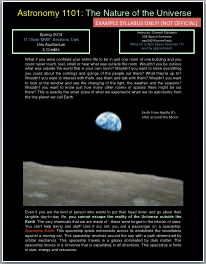Example Syllabus
I chose my goals and objectives as skills and knowledge that students can take away from this course rather than simply things they learn once for a test and forget. They are innovative because they try to draw out the relevance of the skies and astronomy to our everyday lives -- what we experience when we look up and how the tools of science can be learned through Astronomy content and applied elsewhere.
Some additional activities I will use (besides the
traditional lecture and test format) to help foster a connection
between the real Universe and the class material will be an observing
lab and an outside project. The observing lab is already a practice in
many introductory astronomy courses but I hope to use it as a method
to introduce students to the practice of connecting what they see up
there and what they know about celestial navigation. The outside
project will be an opportunity for students to apply astronomical
principles to their everyday lives. For example, students can choose
take a spectrum of a flower and the responses of our eyes' cone cells
to understand why it is appears yellow, use polarized sunglasses to
study the way light reflects off a lake, calculate the relative
distance of light bulbs from their brightness, or test what materials
are transparent to infrared light of their TV remote using a digital
camera.

Example 1101 Syllabus